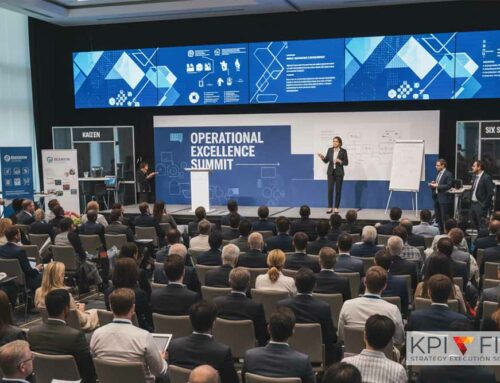Welcome to the secret weapon of high-performing teams: the team huddle. Forget long, draining meetings. This is a quick, focused burst of energy designed to get your team aligned, energized, and ready to crush their goals. At KPI Fire, we know that hitting your KPIs isn’t about working harder; it’s about working smarter and staying in sync. A great huddle is the daily spark that keeps your team’s momentum alive and your goals on track. In this post, we’ll dive into what makes a team huddle more than just a stand-up meeting. We’ll also share 10 game-changing ideas to inject some serious energy and focus into your daily huddle, transforming it from a routine check-in into a powerful launchpad for success.
The Core Principles of a Team Huddle
A great team huddle isn’t an accident; it’s built on a few non-negotiable principles. These tenets are what differentiate a huddle from a standard meeting and give it its power. By adhering to these rules, you can ensure your huddle is a consistent source of value rather than a drain on time and energy.
Brevity is Key
A huddle should be short. The ideal duration is between 5 and 15 minutes, no matter the size of the team. This forces everyone to be concise, to get straight to the point, and to focus only on what is essential. This brevity respects everyone’s time and prevents the conversation from drifting into tangential topics.
Standing Room
The physical act of standing has a powerful psychological effect. It prevents people from getting too comfortable, naturally keeps the meeting short, and encourages a sense of urgency. It also puts everyone on a level playing field, regardless of their role or title, fostering an environment of open and direct communication.
Routine and Consistency
The most effective huddles are held daily, at the same time and in the same location. This predictability makes it a non-negotiable part of the team’s routine. It helps maintain momentum, catches small issues before they become major problems, and ensures a constant flow of information.
The Power of Three Questions
The simplest and most effective huddle structure revolves around three questions:
-
- What did I do yesterday? (Briefly report on progress.)
- What will I do today? (State your top priority for the day.)
- What blockers or challenges do I have? (Identify anything that is preventing you from moving forward.)
This simple framework provides a powerful structure that keeps the huddle on track and helps identify bottlenecks and dependencies in real-time.
The Benefits of a Daily Huddle
When executed correctly, a daily (team) huddle can have a transformative impact on a team’s performance, communication, and morale. The benefits extend far beyond a simple status update.
Improved Communication and Transparency
The huddle is a daily touchpoint that eliminates the need for endless email chains or individual messaging for status updates. Everyone hears the same information at the same time, reducing miscommunication and ensuring a unified understanding of priorities. It creates an open and transparent environment where problems are surfaced and addressed immediately.
Quick Problem Identification and Resolution
By asking about roadblocks or “blockers”, the huddle provides an early-warning system. A team member might mention a dependency issue with another department, a technical glitch, or a lack of resources. These are “red flags” that can be noted for immediate follow-up. This prevents small problems from escalating into major project delays.
Enhanced Alignment and Focus
In a huddle, every team member states their primary focus for the day. This provides a clear, shared picture of the team’s collective priorities. When there is a stronger sense of strategic alignment on what needs to be done, there’s less wasted effort and a clearer path to achieving strategic goals.
Boosted Morale and Team Cohesion
A huddle is a low-stakes, high-impact way to build camaraderie. It’s a chance for team members to hear about each other’s successes, offer support on challenges, and feel like they are part of a unified effort. This simple, daily ritual reinforces a sense of community and shared purpose, which is critical for a high-performing team.
Increased Accountability
When everyone publicly states their commitments for the day, a subtle but powerful form of team accountability is established. This isn’t about shaming or micro-management; it’s about creating a sense of shared responsibility. Team members are more likely to follow through on their tasks when they know their peers are aware of their commitments.
10 Ideas to Supercharge the Team Huddle
While the core principles are essential, adding a bit of creativity can make your team huddles even more engaging and effective. Here are ten ideas to help you move beyond the standard format and inject a dose of energy and focus into your daily routine.
1. The “One Win” Share
Before diving into the three questions, ask each person to share one small win from the previous day. This could be anything from a solved technical problem to a positive customer interaction. Starting the day with a note of positivity can significantly boost team morale and energy. It helps reinforce a culture that celebrates progress, not just results.
2. The “Parking Lot” Rule
Not every topic belongs in a huddle. When a discussion threatens to become a deep-dive, use a “parking lot” rule. The huddle facilitator should note the topic and the relevant people, and then schedule a separate, follow-up meeting to address it. This keeps the huddle on track and ensures complex issues get the dedicated time they deserve without derailing the group.
3. Introduce a “Question of the Day”
Start the huddle with a quick, non-work-related question to get everyone talking. For example, “What’s the best movie you’ve seen recently?” or “What’s the best thing you’ve eaten this week?” This simple icebreaker can lighten the mood, foster a more personal connection, and make the huddle feel less like a rigid status report.
4. Visual Prompts
Use visual aids to keep the huddle focused. A whiteboard with the three key questions, a dashboard showing the team’s top KPIs, or a project board can serve as powerful visual management anchors. These tools help to make the abstract visible and keep everyone’s attention on the shared team goals.
5. Use a Tool to Keep It Honest
Tools like Standup Alice are built specifically to streamline the team huddle process. It helps teams track their three questions, manage a digital parking lot, and ensure accountability. It’s a great way to ensure the huddle remains productive, even for remote or distributed teams. You can find out more about it here: Standup Alice.
6. Rotate the Facilitator
Don’t let one person, especially the team lead, always run the huddle. Rotate the facilitator role among team members. This empowers everyone, builds leadership skills, and ensures that the huddle remains a team-owned process, not a top-down one.
7. The “Shout Out” Session
At the end of the huddle, dedicate 30 seconds for anyone to give a shout-out to a teammate who helped them out or did great work the previous day. This reinforces a culture of appreciation and teamwork.
8. Physical Energizers
For teams that are in person, try a quick physical energizer. Something as simple as everyone doing a quick stretch or a fun group clap can break up the routine and get the blood flowing.
9. Themed Huddles
Occasionally, introduce a theme to your huddle. For example, a “Customer Story Huddle” where one person shares a brief story about a positive customer interaction from the previous day. This helps keep the team’s focus on the end-user.
10. The “What’s Missing?” Question
After everyone has shared their updates, the facilitator can ask, “Based on what we’ve heard, what do we think is the biggest risk for the team today?” This encourages collective problem-solving and proactive risk management.
Leveraging KPI Fire for High-Impact Huddles
A team huddle provides the perfect ritual for continuous improvement, and a tool like KPI Fire provides the essential infrastructure to make that ritual strategic and data-driven. A huddle without a clear focus on metrics can easily become a series of anecdotal updates. By integrating KPI Fire into your huddle, you can transform it from a simple check-in to a powerful mechanism for driving execution.
Here’s how you can leverage KPI Fire to supercharge your team huddles:
HuddleBoard Streamlining
KPI Fire’s huddleboards transform traditional team meetings into focused, efficient huddles by providing a real-time, visual platform for KPIs. These digital boards (see Huddleboard examples) allow teams to instantly see their progress against goals, identify roadblocks, and celebrate successes, all in one centralized location.
By integrating directly with data sources, the huddleboards eliminate the time wasted on manual data collection and chart creation, enabling teams to spend their time on what matters most: collaborative problem-solving and strategic planning. This shift from static reports to dynamic, interactive dashboards fosters a culture of accountability and continuous improvement, ensuring every team member is aligned and informed.
Report on Project Status, Not Just Tasks
The huddle should be a venue to report on the status of high-impact projects. With KPI Fire, you can quickly navigate to your strategic initiatives and see the progress of individual projects. A team member can say, “I’m working on the ‘Website Redesign’ project and have hit a roadblock with the new user authentication feature.” The team can then immediately see the project on the platform and understand the context of the issue.
From Roadblock to Actionable Item
When a team member raises a roadblock, the facilitator can instantly create a new action item or task within KPI Fire, assign it to the appropriate person, and set a due date. This ensures that no issue falls through the cracks. The “parking lot” is now a dynamic, trackable list of items that need follow-up, not just a scribbled note on a whiteboard.
Connect Daily Work to Strategic Goals
KPI Fire helps to visually connect daily tasks, projects and objectives to larger, strategic goals. During the huddle, when a team member reports on their work, they can explicitly reference how it ties back to a company-wide KPI or objective. This reinforces the “why” behind their work and keeps the entire team focused on what truly matters.
Celebrate Successes with Data
When a project is completed or a KPI is achieved, you can celebrate it right there in the huddle. The team can see the final green checkmark or the positive trend on the dashboard, making the win feel more tangible and rewarding.
By integrating a purpose-built platform like KPI Fire, your team huddle becomes more than a routine—it becomes a central part of your continuous improvement program. It’s a tool for transparency, accountability, and real-time execution. To see how KPI Fire can transform your team’s productivity and focus, you can request a demo and discover how it bridges the gap between strategy and execution by providing real-time visibility into metrics.
Don’t let your team’s potential get lost in long, unproductive meetings. Embrace the power of the team huddle and give your team the tools it needs to succeed, one focused conversation at a time.



